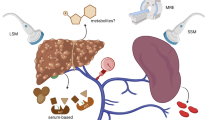Abstract
This study reports how to prevent posthepatectomy liver failure and the crucial factors in evaluation of hepatic reserve. In 1980, we established a prediction score (PS) system for predicting the safe limit of hepatectomy. We used a multiple regression equation: Y(PS)=−84.6+0.933X1+1.12X2+1.0X3, where X1 is computed tomographic scan-estimated resection rate (%), X2 is ICG retention rate (%) and X3 is patient's age. Of the clinically available liver function tests, ICG retention rate or clerance had the highest correlation with biomechanically estimated liver consistency and morpho-metrically estimated collagen content, both of which affect liver regenerative capacity. With the further accumulation of a subsequent 10 years' experience (1981–1990), the system was refined. If a PS greater than 55 was given to a planned resection part it was classified as a risky zone; a PS of 45–55, as a borderline zone; and a PS less than 45, as a safe zone. In the borderline zone, the pattern of the glucose tolerance curve and the presence or absence of coexistent liver disease were determined to be additional prognostic factors. Even if patients were assessed as being in the safe zone by reducing resection range, patients with disturbed glucose tolerance, lower platelet count, and higher ICG retention rate were found to be at a high risk for liver failure secondary to septic postoperative complications. Mortality by liver failure has been reduced with the use of these systems, from 16% before 1980 to 6.3% (24/376, 1981–1990) and to 0.9% (2/202, 1991–1995). Avoidance of excessive resection unmatched to individual hepatic reserve and avoidance of septic complications are mandatory in patients with a limited safe margin of hepatic reserve.
Similar content being viewed by others
References
Okamoto E, Yamanaka N, Toyosaka A, Tanaka N, Yabuki K 1987 Current status of hepatic resection in the treatment of hepatocellular carcinoma. In: Okuda K, Ishak KG (eds) Neoplasms of the liver Springer, Berlin Heidelberg New York, pp 353–365.
Yamanaka N, Okamoto E, Toyosaka A, Mitsunobu M, Fujiwara S, Kato T, Fujimoto J, Oriyama T, Furukawa, K, Kawamura E (1990) Prognostic factors after hepatectomy for hepatocellular carcinoma A univariate and multivariate analysis. Cancer 65:1104–1110
Ong GB, Lee NW (1975) Hepatic resection. Br J Surg 62:421–430
Bismuth H, Houssin, D, Castaing D (1982) Major and minor segmentectomies “Regless” in liver surgery. World J Surg 6:10–24
Malt RA (1985) Surgery for hepatic neoplasms. N Engl J Med 313:1591–1596
Noguchi T, Imai T, Mizumoto R (1990) Preoperative estimation of surgical risk of hepatectomy in cirrhotic patients. Hepato-gastroenterology 37:165–171.
Stone HH, Long WD, Smith RB, Heynes CD (1969) Physiologic considerations in major hepatic resections. Am J Surg 117:78–84
Okamoto E, Kyo A, Yamanaka N, Tanaka N, Kuwata K (1984) Prediction of the safe limits of hepatectomy by combined volumetric and functional measurements in patients with impaired hepatic function. Surgery 95:586–591
Okamoto E, Yamanaka N, Kyo A (1981) Accurate measurement of maximal resection limit of liver by CT scan (in Japanese). Shoukakigeka (Gastroenterol Surg) 4:1373–1378
Yamanaka N, Okamoto E, Kuwata K, Tanaka N (1984) A multiple regression equation for prediction of posthepatectomy liver failure. Ann Surg 200:658–663
Yamanaka N, Okamoto E, Toyosaka A, Ohashi S, Tanaka N (1985) Consistency of human liver. J Surg Res 39:192–198
Katoh T, Yamanaka N, Okamoto E (1993) Some problems in estimating ICG Rmax and its clinical significance (in Japanese with English abstract). Nichishougekakaishi 26:984–991
Katoh T, Yamanaka N, Okamoto E (1993) Preoperative evaluation of severity of liver fibrosis by multivariate analysis (in Japanese with English abstract). Kanzou (Acta Hepatol Jpn) 10:791–797
Yamanaka N, Okamoto E, Kawamura E, Katoh T, Oriyama T, Fujimoto J, Furukawa K, Tanaka T, Tomoda F, Tanaka W (1993) dynamics of normal and injured human liver regeneration after hepatectomy as assessed on the basis of computed tomography and liver function. Hepatology 18:79–85
Tanaka W, Yamanaka N, Oriyama T, Katoh T, Okamoto E (1997) A multivariate analysis for regenerative capacity after hepatectomy in humans. J Hep Bil Pancr Surg 4:78–82
Nambu M (1966) Hepatic clearance of indocyanine green in liver diseases (in Japanese) Jpn J Gastroenterol 63:777–794
Yamanaka N, Okamoto E, Oriyama T, Fujimoto J, Furukawa K, Kawamura E, Tanaka T (1994) A prediction scoring system to select the surgical treatment of liver cancer. Ann Surg 219:342–346
Ozawa K, Ida T, Yamada T, Honjo I (1976) Significance of glucose tolerance as prognostic sign in hepatectomized patients. Am J Surg 131:541–546
Yamanaka N, Okamoto E, Tanaka T, Oriyama T, Fujimoto J, Furukawa K, Kawamura E (1995) Laparoscopic microwave coagulonecrotic therapy for hepatocellular carcinoma. Surg Laparosc Endosc 5:444–449
Okamoto E, Yamanaka N, Fujimoto J, Toyosaka A, Mitsunobu M (1991) The role of surgery in the treatment of hepatocellular carcinomas. Gann Monograph Cancer Res 38:193–201
Okamoto E, Yamanaka N, Oriyama T, Tomoda F, Kyo A (1994) Prediction of the safe limits of hepatectomy by combined volumetric and functional measurements in patients with impaired hepatic function. In: Sugarbaker PH (ed) Hepatobiliary cancer. Kluwer Academic. Boston Dordrecht London, pp 293–299
Author information
Authors and Affiliations
About this article
Cite this article
Yamanaka, N., Okamoto, E. How do we determine the safe limit of hepatectomy based on multiple crucial factors?. J Hep Bil Pancr Surg 4, 235–240 (1997). https://doi.org/10.1007/BF02489019
Received:
Accepted:
Issue Date:
DOI: https://doi.org/10.1007/BF02489019




